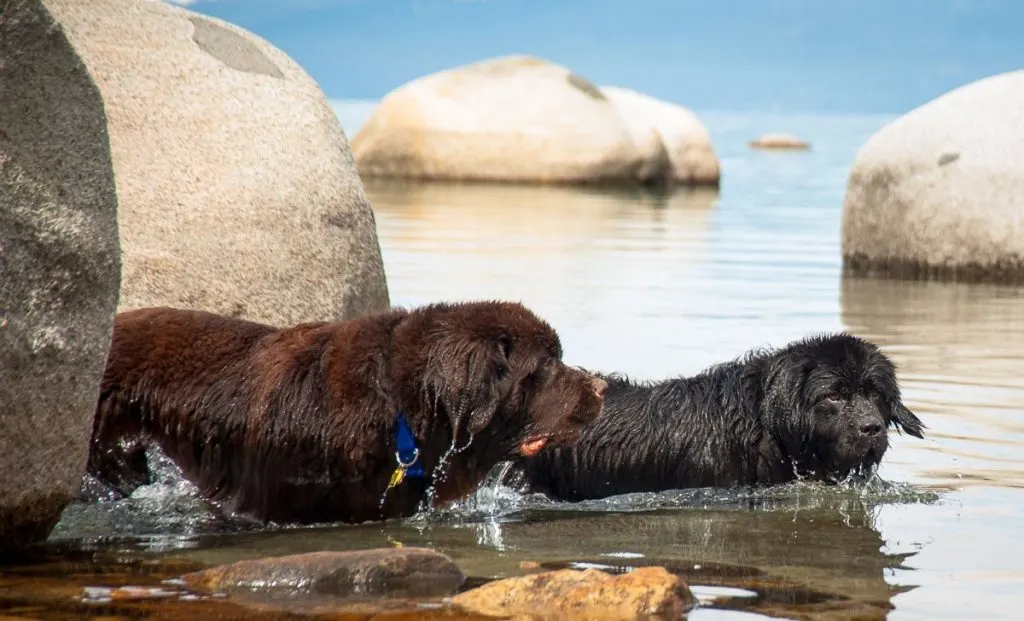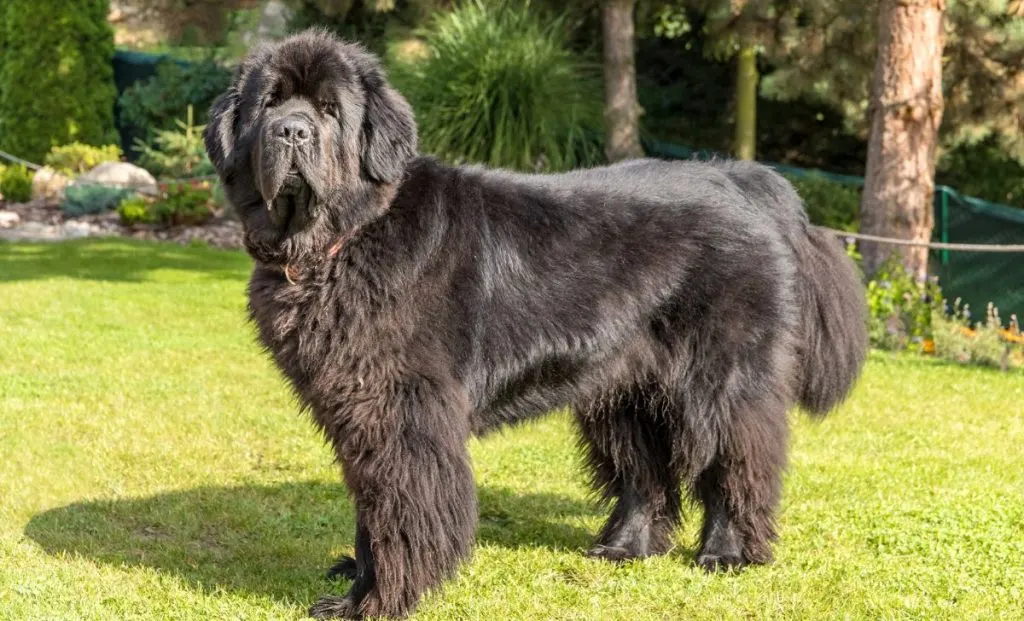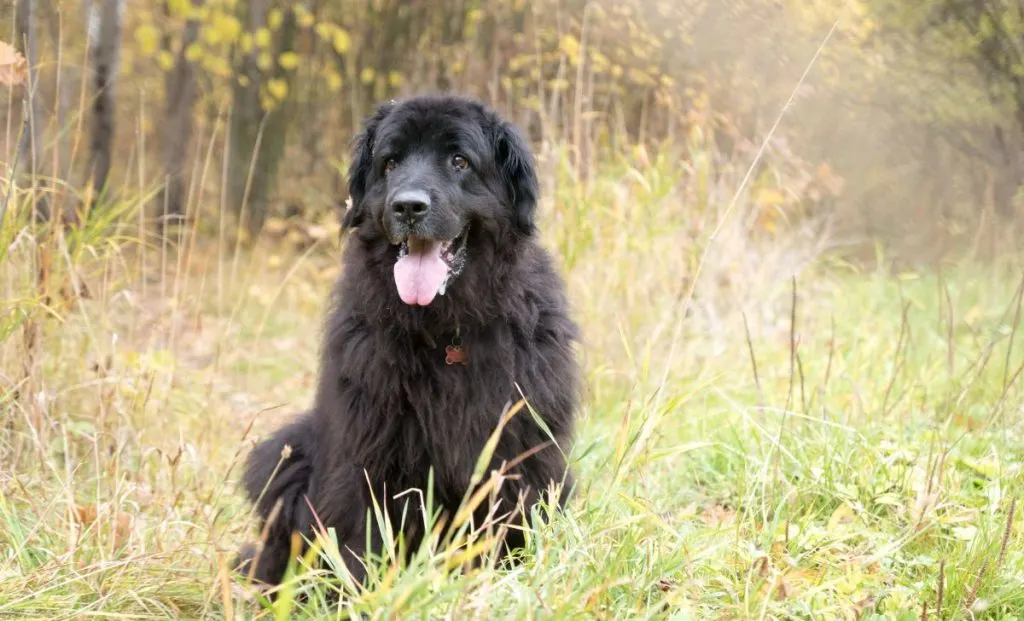When choosing the right dog breed, there are many things you need to consider. This includes the dog’s gender. So, which one is better, male vs female Newfoundland?
The gender of your future dog can be more important than you think. This can impact almost every aspect, from trainability and temperament to appearance.
It’s important to learn which sex is right when planning to get a Newfie pup. Otherwise, you might end up with a dog that is too much for you.
And no, these aren’t just prejudices.
So, when it comes to Newfoundlands, how essential is gender? Let’s find out!
Male Vs Female Newfoundland Quick Overview
| Male | Female | |
| Height | 27 – 29 inches | 25 – 27 inches |
| Weight | 130 – 150 lbs | 100 – 120 lbs |
| Temperament | Protective, loyal, affectionate | Loyal, independent, patient |
| Training | Easy to train | Moderate to train |
| Social Behavior | Friendly to everyone | Prefers one family member |
| Energy Levels | Moderate | Moderate |
| Affection Levels | High | Medium |
Visual Differences

Differences in appearance are the first thing anyone notices when looking into male vs female Newfoundland.
While these aren’t as important as some other differences on this list, we are visual creatures, so it’s no surprise many people wonder about them.
In general, the Newfoundland dog is a giant breed. Known for its long, black coat (although it can come in a few other shades – for example, white Newfoundlands) and loud bark, this pup can hardly go unnoticed anywhere it goes.
You can check their official breed standard with the American Kennel Club (AKC) to get a better idea about common desirable traits.
It might be challenging to differentiate males from females just by looking at them. However, a few slight differences in size exist.
Male
While both genders are known for their large size, males are a bit larger – something quite common in many dog breeds.
Their average height is anywhere between 27 and 29 inches, although some males can be even taller.
As for their weight, they typically reach anywhere from 130 to 150 lbs. This is more than the average human weight!
Female
While female Newfies are somewhat smaller, they are still massive dogs.
They easily reach a height of up to 27 inches, and their average weight is 100 to 120 pounds.
While significantly smaller than males, they might still be bigger than some of their owners!
Also, some pet parents swear their coats are silkier and shed more as a result, but there isn’t much proof for this claim.
Temperament

Unlike physical differences, temperamental differences are quite more prominent.
In fact, they are the reason most aspiring Newfie owners should carefully consider the gender of their future puppy.
All Newfoundlands are loyal and loveable despite their appearance, which some people consider scary.
They are true gentle giants, although a bit territorial and protective, so some things need to be thought about on time.
As they are a big breed, it’s important to understand every aspect of their temperaments so you can control them if such time comes.
Here are some key differences in male vs female Newfoundland’s behavior:
Male
Male Newfoundlands have a stereotypical “male dog behavior.” If you look at most dog breed gender comparisons, such as Anatolian Shepherds, you’ll probably notice the pattern.
These pups are friendly and goofy and love to be the center of attention. They will love all family members equally as long as they’re willing to play with them and give them a pat on the head.
At the same time, however, they are quite protective and territorial. They’re not aggressive in the slightest, but their big size can make them a danger if you don’t find a way to train them on time.
They are needy and more prone to separation anxiety, which can be an issue for people working 9 to 5 jobs.
Female
Females are the bossier of the two genders. They like to have things done their way, and they might avoid any activities they dislike.
While calmer and less territorial, they are very protective and will do all in their power to keep you out of danger.
They will want your attention but won’t go out of their way to get it, expecting you to do all the work. However, they don’t need to be the center of every party and prefer to have alone time more often than not.
They typically create strong bonds with one or two family members, and they’ll never leave their sides.
This isn’t to say they won’t be friendly with other family members – on the contrary. Still, you’ll always know who her favorite is.
Also, they are very patient. While still a better choice for older children, they can be good companions for small kids, as well, as they are less likely to push them or lash out at them during play times.
Still, they are rarely dogs for cuddling, and while most of them will love a good petting session, they usually won’t come to you for anything more than a tummy rub.
Finally, they are generally calmer and lazier and won’t run around the house as often, except at a very young age.
Trainability

Many people think dog training is only about pups learning new tricks, but it’s much more complex than that. It’s also essential for teaching your dogs how to behave and be obedient.
Trainability is very important with all dog breeds, from Chihuahuas to German Shepherds. However, it is essential when dealing with big breeds, such as the Newfoundland dogs.
While naturally friendly and non-aggressive, you still need to make sure your Newfie is properly trained to avoid any behavior problems.
Not to mention how controlling an untrained dog of this size isn’t an easy task, and you don’t want your pooch to fall into trouble.
As trainability greatly depends on the dog’s temperament, it’s already easy to guess that there will be some differences between genders.
Male
Due to their friendly and clingy temperament, males are more eager to please and listen to their owners. They’ll do everything they can to keep their family members happy, and this includes obedience training.
This good temperament, combined with their high intelligence levels, makes them one of the easiest dogs to train!
Of course, it’s important to start training at an early age to make sure your Newfoundland puppy is ready to face the world without getting into trouble.
Due to their protective temperaments, you need to pay special attention to early socialization. This will ensure your pup is familiar with other dogs, pets, humans, and new environments.
Without proper socialization and temperament, your Newfie can get out of hand and cause distress, and this is something you need to avoid.
In the most severe cases, your Newfie might even end up aggressive!
Luckily, this task won’t take too much of your energy, and you’ll be able to spend most of your time playing.
Female
While still loving dogs, females are a bit more challenging to train. They are more independent and less likely to want to please everyone, especially if they don’t think training is fun.
Also, females tend to have mood swings, especially if they aren’t spayed. When in a bad mood, it might be entirely impossible to train them, as they’ll just want to be left alone.
While just as intelligent as males, they can be more stubborn, so it can take you a longer time to teach them how to listen to basic commands.
Early socialization is also very important, considering how they, too, can be somewhat protective and wary of strangers.
However, they don’t need as much of it as males (although you can never go overboard when it comes to introducing new environments and animals to your pup).
In general, a good idea is always to find new ways to keep your female pup entertained during training and to make sure the training doesn’t last for a long period of time. This will help you to train your female dog with as little resistance as possible.
Which One Is A Better Guard Dog?

Newfies were originally bred to be mountain and water rescue dogs. Their long coats help them withstand cold weather and heavy snow, and they are very good swimmers.
However, many people keep them to be guard dogs, and they can do this task very well.
Both genders excel at keeping your home safe. However, there are some pros and cons to both genders when it comes to this activity.
As males are easier to train, they are typically better-working dogs since you can teach them to do exactly what you want with ease.
However, their focus can be short, and they might be more interested in getting all the attention possible rather than alerting you of the newcomers.
Females, on the other hand, are more aloof around strangers, and they’ll inform you whenever they notice anything wrong.
However, they are lazier and can be more challenging to train.
Which One Is A Better Family Pet?

Both genders can also make an amazing family pet, but, once again, it all comes down to your preferences and the individual dog’s temperament.
As mentioned, males are friendlier, and they’ll love everyone. They are lovable dogs everyone will fall in love with! This can make them a great choice for large families.
However, due to their high activity levels and not knowing when to stop, it isn’t a good idea to leave them alone with small children, as they might injure them by accident.
Opposite of that, females are nurturing and caring, and they are quite suitable for young kids, even toddlers. However, they aren’t as friendly, and too large families might be overbearing for them, especially if they don’t have a safe space where they can spend some time alone.
Also, females might be more suitable for other pets, as they aren’t as territorial.
Health And Lifespan

Health care is something we must provide all our dogs with.
Sadly, like most large dog breeds, Newfies are prone to some health problems, such as joint issues, hip and elbow dysplasia, and bloat.
There are only a few gender-specific conditions concerning their reproductive organs.
For example, males might get testicular cancer, prostate problems, or paraphimosis.
Females can get ovarian or uterine cancer, false pregnancies, or pyometra. Also, they are more prone to UTIs than males.
Regular check-ups with the vet are the best way to ensure your dogs live a long and happy life free of health disorders.
As for their lifespan, both male and female Newfoundlands can live around 7 to 10 years, which isn’t too bad for a breed of their size.
Conclusion

So, which one is more suited for you when it comes to male vs female Newfoundland?
The truth is – it greatly depends on your own preferences and the dog’s individual temperament.
All dogs have their own personality, and they might behave quite unlike their breed and gender. When getting a new pet, you need to have an open mind and be fully wary of that.
Generally speaking, males are a better choice for large families and less experienced owners who might not have the nerve to deal with a female’s moodiness during training.
Females are a better choice for small families and owners who know how they need to have a little persistence when training.
Either way, if you’re looking for a large, fluffy dog that will make sure you are safe while also being your best friend, you won’t make a mistake.

Vanja’s passion for writing started at an early age, which is why she pursued Journalism as her college degree. She can research any topic and find all the information before you bat an eye, which is a great thing for her job but a terrible one for her husband.
Even as a young child, she fell in love with everything fluffy – but dogs have a special place in her heart due to her childhood companion, a Corgie named Archie.
Motivated by her experiences and driven by a desire to give back to her four-legged companions, she spends her free time volunteering at a local dog shelter.
